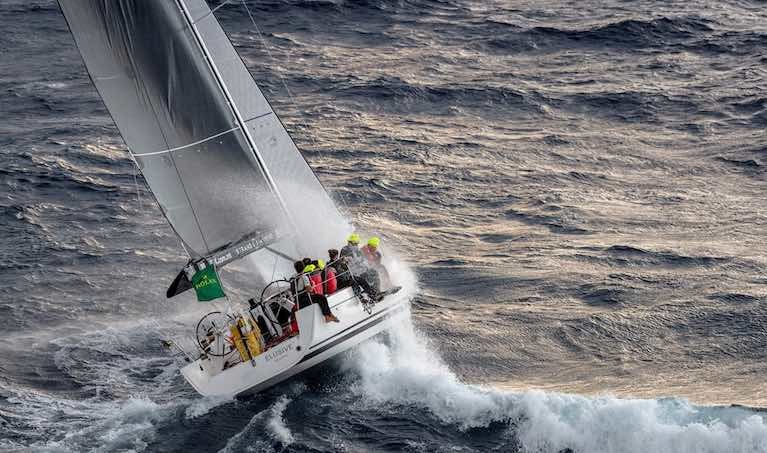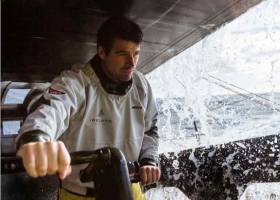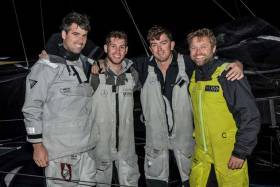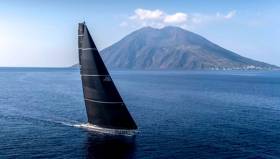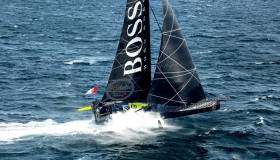Displaying items by tag: Nin O'Leary
Royal Cork's Nin O'Leary Leads Irish Crew on Superyacht Aragon for Sardinia's Loro Piana Regatta
Dublin Bay, Howth and Cork Harbour crews will race the latest 29-metre Aragon in Sardinia next week at the prestigious Italian superyacht Loro Piana Regatta.
Dun Laoghaire Harbour's Cian Guilfoyle fresh from last week's RC 44 Cup as Afloat reported here, joins the Aragon team for the first time. His knowledge of handling 400+ square metre spinnakers will see Guilfoyle assisting a bow army of six crew.
There is a further Irish connection this year for the Aragon crew given the fact that the latest Aragon is in fact ex-Windfall, Mick Cotter's Dun Laoghaire to Dingle Race record-breaker.
Just to ensure there’s Irish presence at every part of the Southern Wind 94-footer, Royal Cork Yacht Club's Nin O'Leary is overseeing the tactical role in the afterguard of Aragon.
As regular Afloat readers will know, O'Leary is a regular tactical presence on the Aragon crew having most recently competed in the 2020 Middle Sea Race.
 Aragon, the 29-metre superyacht, previously known as Windfall, was a record-breaker in the 2019 Dun Laoghaire to Dingle Race
Aragon, the 29-metre superyacht, previously known as Windfall, was a record-breaker in the 2019 Dun Laoghaire to Dingle Race
All three areas will be in a loop of headsets/walkie talkies for clear communications and crew work to coordinate the 25 crew members during the Loro Piana Cup.
Racing begins at the Mediterranean venue on June 2nd to 6th under the ORC–Super Yacht rule and rating system.
Pursuit races will be set over a course length with the smaller vessels going off first. If everyone sails to their handicap without any hiccups all boats should cross the finish-line bow to bow.
To add to the tactical conundrum of manoeuvring a 60ton sloop, the Superyacht rule does not allow competing craft to come within 40 metres of each other.
Range finders bow and stern will be deployed as well as the assistance of AIS for judging passing distances.
Cork Harbour's O'Leary is currently delivering Aragon from Palma to Sardinia for next week's regatta.
Class One Win for Nin O'Leary as Elusive 2 Maintains IRC Overall Lead to Finish of Middle Sea Race
A strengthening breeze from the southeast has brought the key middle group of top handicap win contenders in the 41st Rolex Middle Sea Race from Lampedusa through the night and the early hours of this morning to the finish at Malta. And though the wind drew more from the east to head them as they neared Valetta, the leading home team of the Podesta family in the First 45 Elusive 2 retained the first place on handicap in which they'd clearly emerged at the Lamepdusa turn, and took what now looks like an unassailable overall win in the 41st Rolex Middle Sea Race.
Once she'd found the breeze, Elusive's performance improved even further, and she lengthened her corrected overall lead to almost exactly two hours ahead of Dominique Tian's Ker 46 Tonnere de Glen (originally Piet Vroon's Tonnere de Breskens, and no stranger to the Round Ireland Course).
The top eight places as currently finished have underlined the exceptionally international nature of this race, which attracted entries from 21 countries, and saw 15 nations represented at the start – with crew from many more - even after pandemic restrictions reduced the boat numbers.
Third place saw a return to the frame by the Belgian Swa 50 Baltahasar (Louis Balcaen), 4th was the TP52 Freccia Rossa from Russia, 5th was the Aquila 45 Katsu from Germany, 6th was Teasing Machine from France, 7th was Hagar V from Italy and 8th was Aragon from The Netherlands with Nin O'Leary on board, which was first on IRC of the boats above 70ft and winner of Class 1.

Crosshaven's Nin O'Leary Gives Aragon the Rock-Star Glitter in Ace Start to Middle Sea Race
Nice one, Nin. With a sailing rockstar recruited into your crew, it's reasonable to expect a 22-carat gold rockstar introduction to the on-stage performance. And Crosshaven super-helm Nin O'Leary certainly came up with the goods at the start of the Rolex Middle Sea Race in Malta yesterday, when he sliced out of the harbour in one single uninterrupted port tack with the Dutch-owned R-P/Marteen 72 Aragon, getting clear first into open water when others further down the line in the classes coming along later saw some time-consuming experiences of zig-zagging in the in-harbour flukey winds.
Although the organisers were still looking at 71 starters from 21 countries a week ago, as the start approached and the COVID-19 shutters came down with increasing severity in Europe, there were drop-outs. These included the famous Lombard 45 Pata Negra on charter to Andrew Hall of ISORA and Pwllheli, and in the end the Royal Malta YC did well to get just under 50 boats from 15 countries heading away on the 606-mile course anti-clockwise round Sicily and assorted islands.
 The Rolex Middle Sea Race Course has everything except – for the moment – record-making wind strengths
The Rolex Middle Sea Race Course has everything except – for the moment – record-making wind strengths
They are doing it in a weather pattern of lightish winds which has already ruled out any possibility of a new record, but has nevertheless given the small but select Irish representation at the front of the fleet their time in the limelight. For in addition to the O'Leary talent on Aragon, the MOD 70 trimaran Mano, with Mikey Ferguson of Belfast Lough on board, was leading the multi-hulls.
It was a frustrating business getting along Sicily's East Coast and through the Straits of Messina, and out ahead among the multis the leader after putting Stromboli astern was Maserati with Mano third, while in IRC the Volvo 70 I Love Poland was the front runner.
 The Belgian Swan 50 Balthasar was overall leader at Messina
The Belgian Swan 50 Balthasar was overall leader at Messina
However, on corrected time at Messina, the IRC leader was the Swan 50 Balthasar (Louis Balcaen, Belgium), but the Podesta family of Malta's defending champion, the First 45 Elusive 2, was well in touch in third, just 20 minutes being the Belgian boat on CT.
And of the biggies, Aragon was doing best - she was sixth overall, on Corrected Time, close behind two boats with strong Round Ireland Race links, Eric de Turckheim's Teasing Machine and Tonnere de Glen, the former Piet Vroon Ker 46 Tonnere de Breskens
There's no "ocean racing" course quite like the Middle Sea, and in the current weather setup, there'll be plenty of frustration and placing upsets before they finish. But at least this very special race is up and running, and taking part in it is just about the healthiest thing that those involved could be doing.
Nicholas O'Leary's Vendee Globe 2020 Bid Makes 'Great Strides' as Boat Goes Up for Sale
Nicholas O'Leary's 'Ireland Ocean Racing team' say it is making 'great strides' towards securing the Cork solo sailor a position on the Vendee Globe 2020 startline despite the fact his boat, purchased last November, has appeared on the international boats for sale market. The move to sell the boat, according to promoters, is 'standard practise' and could yield a new boat for O'Leary for the round the world race.
The Royal Cork Yacht Club ace, a multiple Irish sailing champion, is aiming to complete the non-stop solo round the world race without assistance in a first for Irish sailing.
Typical Vendee Globe campaigns run into millions of Euro for the 80–day race.
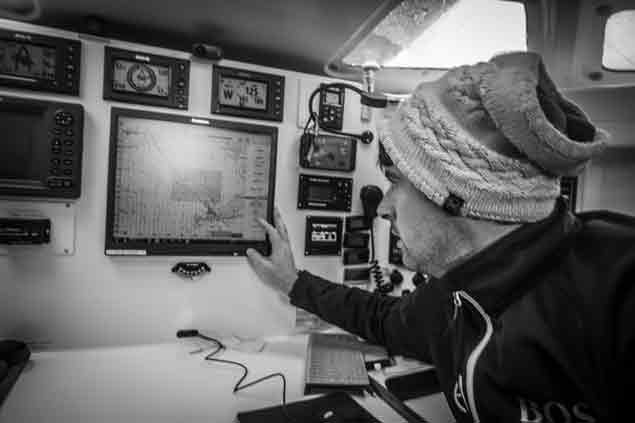 Nicholas O'Leary at the Nav station on board his IMOCA 60 yacht
Nicholas O'Leary at the Nav station on board his IMOCA 60 yacht
O'Leary's 2006–built 'Great America IV' is a veteran of the last race. Since the boat arrived into Dun Laoghaire Marina last winter, O'Leary (32) has been based largely on Dublin Bay and Cork Harbour. Last April, the boat arrived back into Crosshaven with a sponsorship makeover, sporting prominent 'Ireland.com' decals, the logo of Tourism Ireland, the agency responsible for marketing Ireland overseas as a holiday destination.
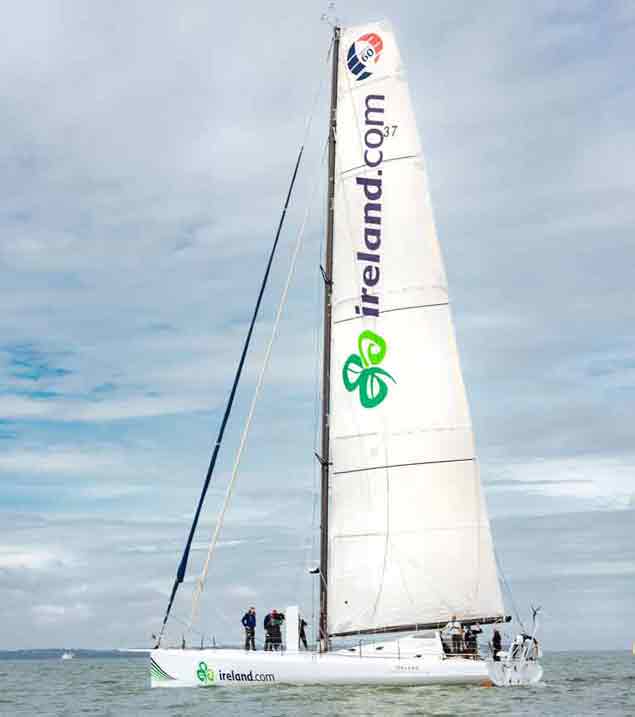 New livery – The Tourism Ireland branded O'Leary IMOCA 60 off Cork Harbour in March
New livery – The Tourism Ireland branded O'Leary IMOCA 60 off Cork Harbour in March
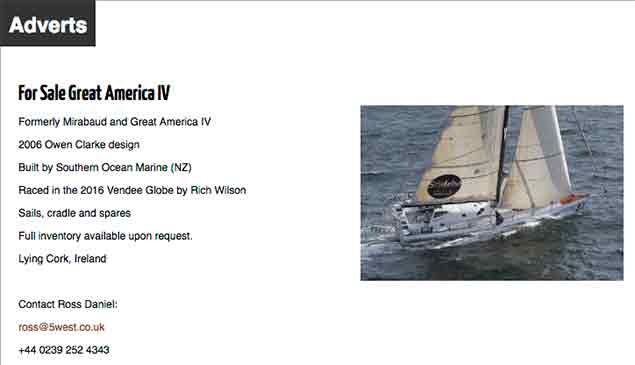 The advert (above) for Nin O'Leary's boat is posted on the IMOCA 60 website
The advert (above) for Nin O'Leary's boat is posted on the IMOCA 60 website
"The boat being advertised is standard practice. Currently, we are looking at a range of options including new boats", O'Leary's General Manager, Georgina Foley told Afloat.ie
"It’s routine to keep these boats on the market to ensure that options remain open", according to Foley.
Only 100 people have sailed single-handed non-stop around the world and no Irish sailor has yet completed the Vendée Globe but if Royal Cork's Nicholas O'Leary has his way, he'll be the first, he told crowds at the launch of his project a year ago at the Royal Irish Yacht Club in Dun Laoghaire.
In the last race, Galway sailor Enda O'Coineen became the first ever Irish Vendee Globe entry, but was dismasted off New Zealand then, months later, gallantly completed the course to 'unofficially' finish the race in March. Read all about O'Coineen's saga here. O'Coineen is now assisting Irish sailors including O'Leary, who are keen to follow in his wake.
 Nicholas 'Nin' O'Leary (second from right) played a key role in Dave Cullen's Wave Regatta success in Howth this month. Photo: Afloat.ie
Nicholas 'Nin' O'Leary (second from right) played a key role in Dave Cullen's Wave Regatta success in Howth this month. Photo: Afloat.ie
In a busy year for O'Leary, he was in command of a superyacht in the Caribbean in March 2017, had a win in the Round the Island Race last July and success last October in the Middle Sea Race. This season, on the domestic circuit, he helped Dave Cullen to Wave Regatta success in Howth.
The O'Leary team says it is currently in discussions with some leading Irish, French, German and US companies for sponsorship and the fate of the current boat depends on 'where we get to with our partner discussions which are advancing well', Foley said.
Ireland Ocean Racing says it has 'designed its partner engagement model to span across the areas of environmental stewardship, innovative technology, employee performance & development and brand promotion'.
"O'Leary is taking on the single hardest sporting challenge on the planet. This can sometimes get lost in the frenzy to secure partnerships"
Foley said: “We are delighted to see the rising interest amongst both corporates and the general public for this project over the last 12 months. Nicholas is taking on the single hardest sporting challenge on the planet. This can sometimes get lost in the frenzy to secure partnerships".
"Offshore sailing is a relatively unchartered territory for many companies here in Ireland and therefore signing partnerships is a lengthy process. Having said that, Ireland Ocean Racing are encouraged with the way Nicholas O’Leary’s campaign is shaping up and are looking forward to the starting line in Les Sables d’Olonne in November 2020" Foley added.
O'Leary is not the only Irish Vendee Globe bid for 2020, at least three other Irish offshore sailors have their names in the hat too: Mayo solo sailor Joan Mulloy, Sailor of the Year Conor Fogerty of Howth and Clipper skipper Sean McCarter.
This is still very much a developing sport and offers plenty of opportunity for companies from all sectors to get involved, according to promoters.
Royal Cork's Nin O’Leary Shares Hugo Boss’s Success in Middle Sea Race
George David’s Rambler 88 has taken line honours for the owner’s third time in the 608-mile Rolex Middle Sea Race currently finishing in Valetta writes W M Nixon. But Nin O’Leary and Alex Thomson in the IMOCA 60 Hugo Boss have turned in a virtuoso offshore performance to be third home across the line, bested only by the significantly larger Rambler and the 100ft Leopard.
Unlike the Fastnet Race 2017, where Hugo Boss suffered from having to beat the whole way from Cowes to the Fastnet Rock, thereby leaving inadequate space and distance to demonstrate her formidable offwind capacity, in this race the “lovely black boat” was able to lay the course – albeit in often very light winds – most of the way on the anti-clockwise circuit towards the most northerly turning point, the volcanic island of Stromboli.
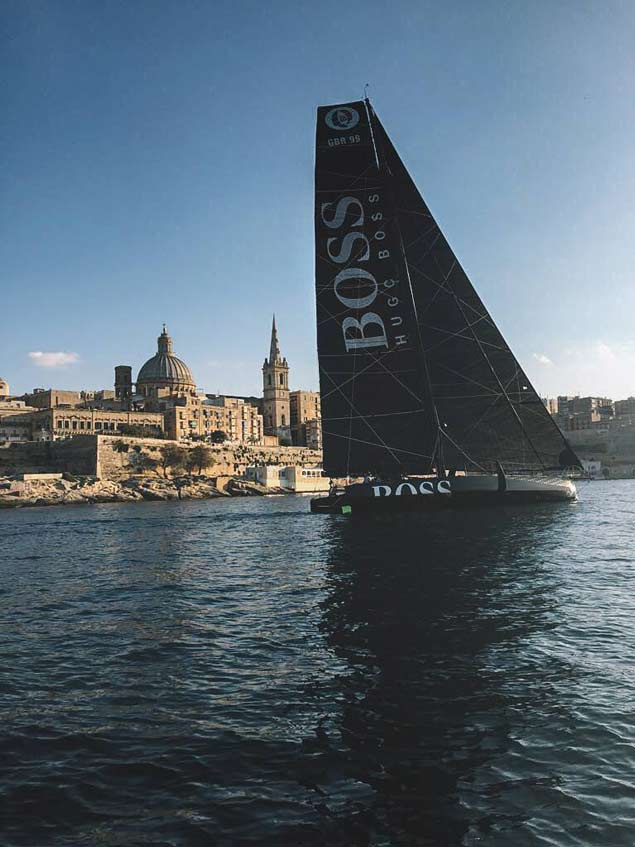 Hugo Boss gets smoothly away from Valetta at the start. Although winds were light all the way to the northerly turn at Stromboli, they were seldom dead on the nose and the specialised IMOC 60 was able to stay well placed. Photo: Kurt Arrigo
Hugo Boss gets smoothly away from Valetta at the start. Although winds were light all the way to the northerly turn at Stromboli, they were seldom dead on the nose and the specialised IMOC 60 was able to stay well placed. Photo: Kurt Arrigo
There, with a west to nor’westerly filling in to eventually become a classic Mistral-generated Mediterranean gale, most of the fleet elected for long tack/short tack progress towards Sicliy’s decidedly rugged northwestly coast’s series of massive headlands. But Hugo Boss’s crew chose to continue to lay on port tack far offshore, accepting the reality that right-on windward work is not their boat’s strong suit.
Thus they found both a slightly more favourable slant of wind well offshore, and a more regular sea state. The northwest corner of Sciliy is notorious for its confused back-wash ridden sea, and when Hugo Boss closed with the fleet again yesterday morning, they were already approaching Sicily’s most westerly race turn at Favignana island, finding themselves in company with the larger boats, and now well ahead of 50ft to 65ft craft which had been hassling them earlier in the race.
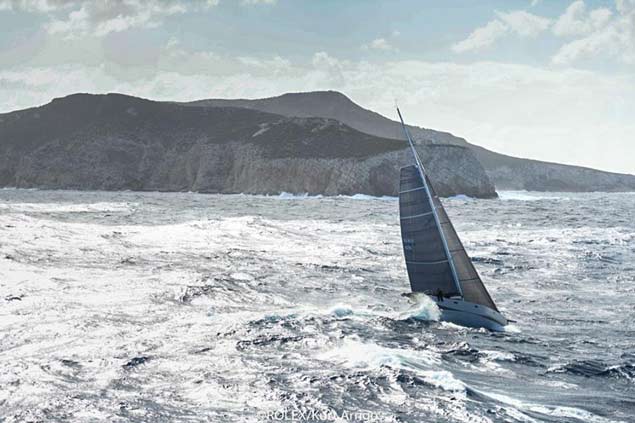 The Botin 65 Caro (Maximilian Klink, Germany) kicks her heels in heavy winds in the backwash-plagued rough seas off Sicily’s northwest coast. Boats that gave much of this coast a good offing, such as XP-ACT and particularly Hugo Boss, benefitted from more regular seas Photo: Kurt Arrigo
The Botin 65 Caro (Maximilian Klink, Germany) kicks her heels in heavy winds in the backwash-plagued rough seas off Sicily’s northwest coast. Boats that gave much of this coast a good offing, such as XP-ACT and particularly Hugo Boss, benefitted from more regular seas Photo: Kurt Arrigo
With Favignana astern, it was all systems go, and at the front of the fleet while Rambler 88 – which was to cover the final 300 miles in 14 hours – was unassailable, for a while Hugo Boss looked as though she might be able to pip Leopard for second place on the water.
It was not to be, as things were easing slightly as the leaders came into Valetta late last night and in the small hours of this morning. With the pace dropping. Rambler 88 was able both to finish first and beat Hugo Boss on corrected time, albeit by just 5 minutes and 26 seconds. But O’Leary and Thompson and their crew of Will Jackson and Jack Trigger (there’s only room for two extra on the very purpose-designed IMOCA 60) were able to beat Leopard (Pascal Oddo, France) by 55 minutes on CT, while Udde Ingvall’s super-skinny Maxi 98 CQS from Australia has finished fourth across the line, almost ten hours astern of Hugo Boss on corrected time.
The severe conditions north of Sicily have taken their toll of the fleet and Irish entries, with Two-Handed favourites Brian Flahive of Wicklow and Sean Arrigo of Malta with the J/122 Otra Vez an early retiral, while Conor Doyle of Kinsale with the DK 46 Hydra had managed to get as far as the great headlands of northwest Sicily before pulling out.
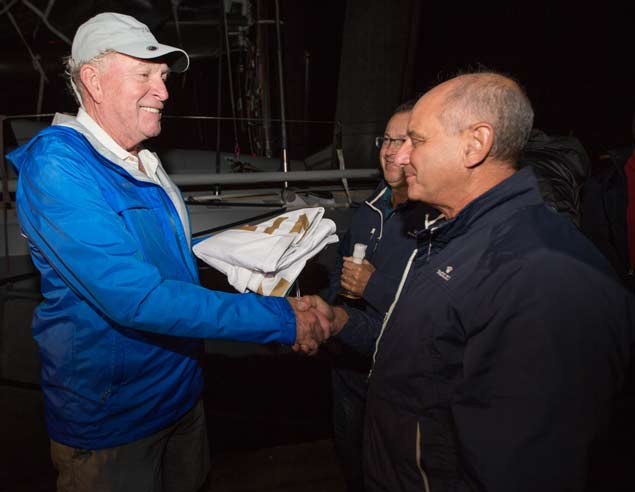 He’s done it again. George David (left) receives the line honours flag for the third time from Royal Malta YC Commodore Godwin Zammit
He’s done it again. George David (left) receives the line honours flag for the third time from Royal Malta YC Commodore Godwin Zammit
But Ireland’s most experienced participant, Middle Sea Race 14-times veteran2012 Barry Hurley, is sailing a really cool race with Shane Giviney and other noted talents on the Xp44 XP-ACT. Having given those bouncy northwestern headlands a decent offing to get them quickly clear while maintaining a good fleet place, they’ve just passed Pantellaria and are lying fourth overall on corrected time.
Current handicap leader is the 2012 Swan 53 Music (James Blackmore, South Africa) while the Russian JPK 10.80 Bogatyr (Igor Rytov) is second and the former Round Ireland star Tonnere de Breskens, the Ker 46 now known as Tonnere de Glen and owned by Tian Domonique of France, is third, with XP-ACT in fourth overall and well clear of the next boat.
Speeds are still well up, but with the wind easing it’s going to be a long day getting past Lampedusa and across to the finish at Valetta.
Race tracker here
Middle Sea Race: Hugo Boss Makes Superb Work of Tricky Conditions, Rambler Recovers From Being Stuck at Stromboli
Everyone going into the 608-mile Rolex Middle Sea Race knows they will experience a challenging course with weather which can be anything and everything from extended calms to surprisingly vicious gales, and the 2017 edition is no exception writes W M Nixon
In mostly light easterly winds after the start on Saturday, the fleet’s stately progress saw George David’s Rambler 88 give a master-class in taking full advantage of every new if small improvement in wind strength, and she lengthened away from the likes of the 100ft Leopard and the 98ft CQS in impressive style, only to see it evaporate again as she was invariably the first one into the next belt of calm.
However, she was always in the lead, and was on the up and up approaching Stromboli yesterday, only to find things very flat beyond that splendid turning point. Increasing desperate to find breeze anywhere, and always looking to be first into the much-forecast strong to gale west to norwest wind which was expected last night, she crawled along at barely a knot and ended out somewhere about nor’nor’east of Stromboli, taking a very wide turn before she began to feel the first of a new air. This eventually became the breeze which gave her a long tack/short tack beat to the next turn at the island of Favignana west of Sicily’s most westerly headland.
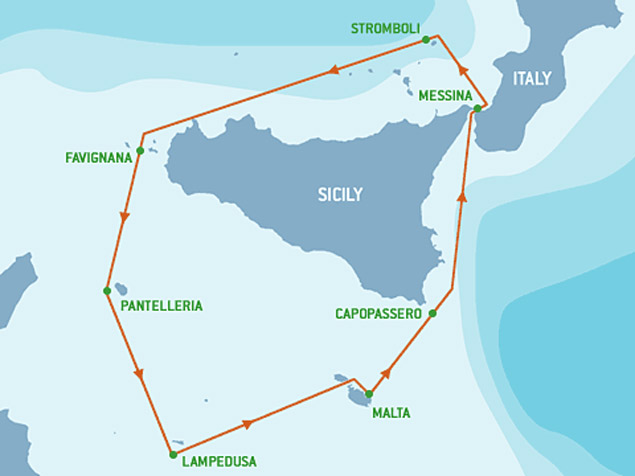 The 608-mile Rolex Middle Sea Race has a bit of everything – and sometimes a lot of wind. Rambler is now on the Pantelleria-Lampedusa stage, tearing along at up to 26 knots in a mighty west to northwest wind.
The 608-mile Rolex Middle Sea Race has a bit of everything – and sometimes a lot of wind. Rambler is now on the Pantelleria-Lampedusa stage, tearing along at up to 26 knots in a mighty west to northwest wind.
It was the IMOCA 60 Hugo Boss (Alex Thompson & Nin O’Leary) which went most determinedly to the northwest. They’d actually arrived at Stromboli at a time when a neat rounding had become possible, but knowing their very special boat’s notable lack of enthusiasm for tacking duels and windward work generally, they slugged on for many miles on port tack until they could hope to lay Favignana without having to tack again.
It was a tactic which worked a treat, and now while the bulk of the fleet are still bashing it out in rugged weather north of Sicily, Hugo Boss is screaming along at 24 knots and more from Favignana towards the next turn at Pantellaria, third on the water to Leopard which is slower at 22 knots, while Rambler is already past Pantellaria and making 26 knots for Lampedusa, the final turn before the finish at Valetta.
The speeds being achieved by the three leaders could well invert the leaderboard’s former emphasis in smaller craft, which still have an awful lot of hard sailing to Favignana before they can let rip. Otra Vez (Brian Flahive & Sean Arrigo) had been well placed in the two-handed division, but now seems to signal retirement, however Xp-ACT with Barry Hurley and Shane Diviney in her crew is well-placed for the Favignana rounding, while Conor Doyle’s chartered Hydra has also made good progress along Sicily’s north coast.
But having seen small boats dominate the top placings early on, we now have the fascinating prospect of the three leading biggies carrying the strong favourable winds all the way to the finish at enormous speeds, and turning the results upside down.
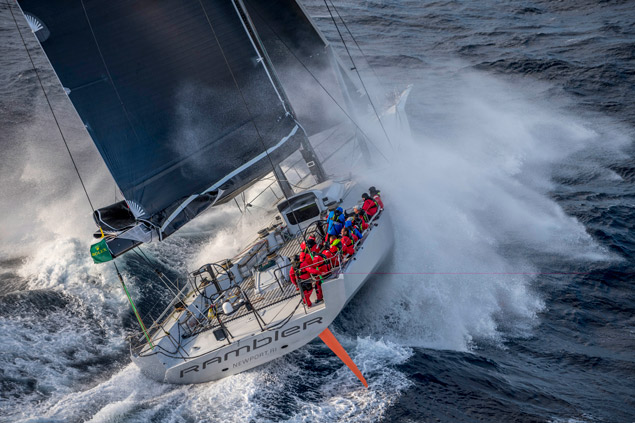 Here we go……Rambler starts to free off as she weathers Favignana at eight o’clock this morning. Photo: Kurt Arrigo
Here we go……Rambler starts to free off as she weathers Favignana at eight o’clock this morning. Photo: Kurt Arrigo
Tracker here
How Much in the Sponsorship Pot for all These Irish Offshore Sailing Superstar Hopefuls?
There have been several Irish offshore racing sailors who have been making national and world headlines for some years now, but in recent weeks and months the wave of new enthusiasm for the big ticket events has surged to fresh heights.
One of the stories underlying all this is the potential for a specialist marine industry base in Cork Harbour serving the continuous needs of the most advanced racing machines, and providing a launch pad for global campaigns. The idea has been around for some time now, but as reported in Afloat.ie as long ago as April 1st 2015, while the goodwill may be there, a firm decision is still awaited.
Local minister Simon Coveney has since moved on from the Marine to other Government departments. His present very senior role in representing Ireland through the Department of Foreign Affairs in decidedly turbulent times will mean that the needs of something so difficult to gauge for significant political and economic benefits will scarcely be top priority.
Yet for the many leading Irish sailors – both men and women – who have launched themselves into the decidedly uncertain world of top level professional competition, the problem of resources and facilities to keep the show on the road is always present, and frequently at crisis levels. W M Nixon wonders how there is going to be enough in the sponsorship pot – both nationally and globally – to help them all fulfill their dreams.
On Tuesday, Afloat.ie received confirmation of a “virtual press conference” in Cork, in other words a clearcut announcement that Nin O’Leary’s co-skippering of the IMOCA 60 Hugo Boss with Alex Thompson was going to move on to a full-blooded Vendee Globe campaign by O’Leary himself, possibly with a new boat.
 The then Minister for the Marine Simon Coveney, Hugo Boss skipper Alex Thomson, and Stewart Hosford at the announcement in Cork in 2015 of a possible international offshore racing hub on Haulbowline Island.
The then Minister for the Marine Simon Coveney, Hugo Boss skipper Alex Thomson, and Stewart Hosford at the announcement in Cork in 2015 of a possible international offshore racing hub on Haulbowline Island.
In the meantime, the word on the waterfront is that the two skippers may do the two-handed Barcelona World Race 2018 in the current boat. But beyond that, the campaign plan for the charismatic O’Leary, mentored by Thomson and orchestrated by Stewart Hosford, is rumoured to be the building up of enough resources to keep this boat, yet also build a new one.
This is because the boat is still almost state-of-the-art, she has some features still absent in other boats, and could be serious opposition in someone else’s hands. Thus the ideal scenario is to maintain control of their current technology and design, while moving on to the next stage of development with an even more advanced boat for the Vendee Globe in 2020.
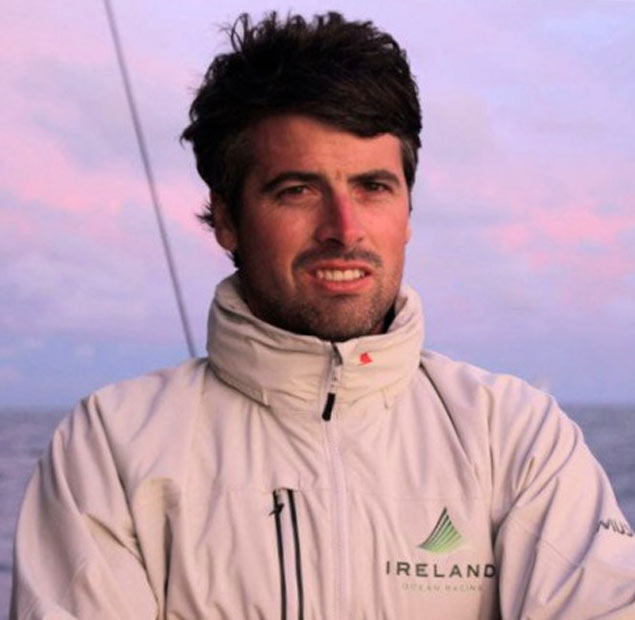 Nin O’Leary – a charismatic figure for Ireland’s younger sailors
Nin O’Leary – a charismatic figure for Ireland’s younger sailors
We’re talking mega-bucks here, and the relationship with Hugo Boss has been very fruitful, but the elephant in the room - which hasn’t been mentioned yet - is how long will the Hugo Boss sponsorship continue?
This may all become clearer within the next ten days, as Thomson, O’Leary and Hugo Boss are headed for Ireland, with Cork in their sights on Monday 28th and Tuesday 29th August, and then they’re in Dun Laoghaire for a very public appearance on Wednesday August 30th, and staying until the Friday, September 1st for the ongoing launch of their new brand Ireland Ocean Racing.
This puts them top of the billboards. But we mustn’t let it blind us to the hopes of other campaigners, and on Thursday of this week, Tom Dolan made his final public appearance in Ireland before returning to France for the countdown towards the start of the Mini Transat 2017 from La Rochelle at the beginning of October.
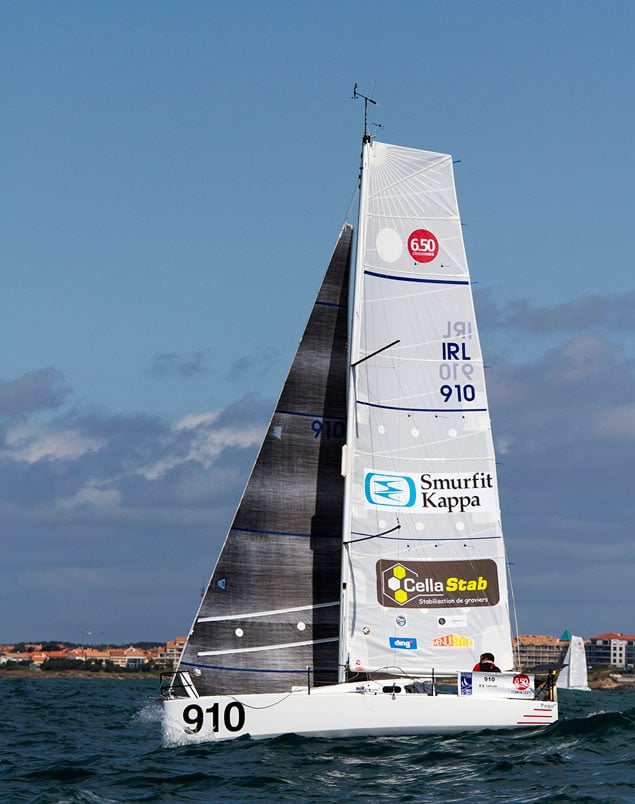 Although Tom Dolan has some sponsorship for IRL 910, there is still a shortfall in funding for the Mini Transat 2017 which starts at the beginning of October from La Rochelle
Although Tom Dolan has some sponsorship for IRL 910, there is still a shortfall in funding for the Mini Transat 2017 which starts at the beginning of October from La Rochelle
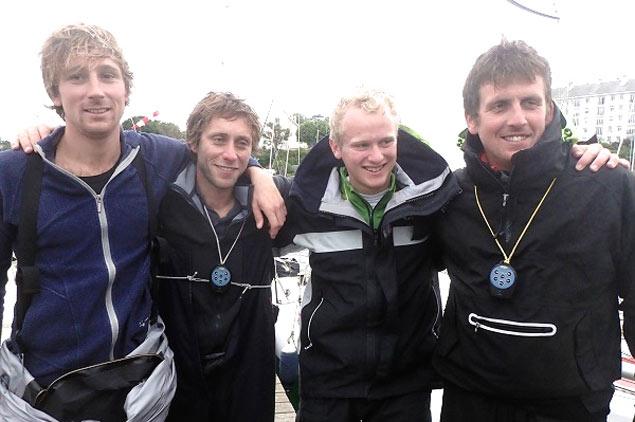 Tom Dolan (right) and fellow skippers in the Mini 650 class at Concarneau. The camaraderie and mutual help among the sailors contributes to France’s dominant position in short-handed sailing
Tom Dolan (right) and fellow skippers in the Mini 650 class at Concarneau. The camaraderie and mutual help among the sailors contributes to France’s dominant position in short-handed sailing
Although Tom has some support backers whose logos appear on his sails, he makes no bones about his overall situation, as his Pogo 3, IRL 910, currently enters races under the name of “Still Seeking a Sponsor”. Whether his presentation in the National YC on Thursday will turn on any money taps in Ireland remains to be seen, the fact is that it’s in France he makes most impact. But in Dun Laoghaire, his burning enthusiasm left an abiding impression, for although his chosen life-path may be more exciting than running the small family farm in Meath, there are times when it’s a massive struggle.
Tom is one of several Irish international offshore wannabees and established skippers who have made a point of having the cup of coffee with Marcus Hutchinson. Hutchinson has transformed himself from being a young sailor who first learned his craft in Howth into an international sailing campaign management figure who maintains his Irish connections through Kinsale, yet is now a key presence at the French-led cutting edge of specialist offshore programmes.
 Marcus Hutchinson is first Port of Call for anyone seriously contemplating a short-handed offshore campaign
Marcus Hutchinson is first Port of Call for anyone seriously contemplating a short-handed offshore campaign
It’s rumoured that in Brittany he has access to a large warehouse full of IMOCA 60s and Open 40s and whatnot. What we do know for sure is that he was very much the background force in Paul Meilhat’s stunning victory in the IMOCA 60 SMA in the recent Rolex Fastnet Race, a neatly-read campaign whose success was highlighted by the inescapable fact that Hugo Boss finished eighth out of the nine IMOCA 60s competing.
SMA with her dagger boards was optimized for windward work, whereas Hugo Boss with her foils most emphatically wasn’t. But while those in the know are aware of this, Joe Public simply sees the final results and takes it from there.
 The Marcus Hutchinson-managed SMA was convincing winner of the IMOCA 60 Class in the Rolex Fastnet Race 2017. Photo: Carlo Borlenghi
The Marcus Hutchinson-managed SMA was convincing winner of the IMOCA 60 Class in the Rolex Fastnet Race 2017. Photo: Carlo Borlenghi
Marcus Hutchinson’s deep well of sound advice is available to those who seek him out, and he is generous with his knowledge and sensible thoughts. Talking to Afloat.ie yesterday morning, he made the point that of the current wave of French superstars in the bigger boats, many have done the Figaro Solo at least a dozen times, and he reckons that setting out to take on the Vendee Globe straight from a career – however successful – in fully-crewed boats, is akin to taking on Everest solo without first trying a few smaller mountains on your own.
The list of those specialist sailors from Ireland who have made a point of seeking advice and assistance at some stage from Marcus Hutchinson is both impressive and fascinating, as it includes Damian Foxall, Justin Slattery, Enda O'Coineen, David Kenefick, Joan Mulloy, Sean McCarter, Tom Dolan and most recently Conor Fogerty.
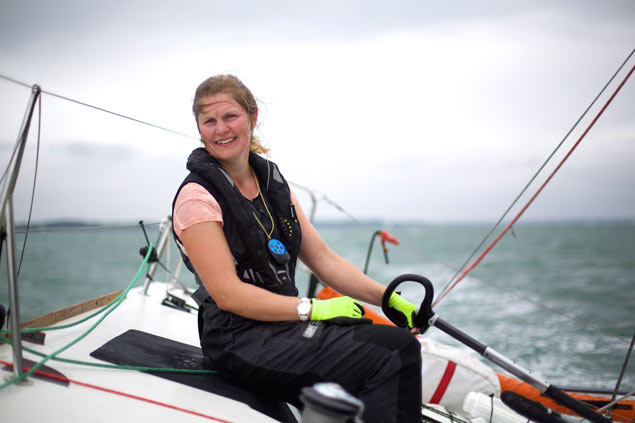 Joan Mulloy of Westport in County Mayo has secured a Figaro through Marcus Hutchinson, but still requires sponsorship
Joan Mulloy of Westport in County Mayo has secured a Figaro through Marcus Hutchinson, but still requires sponsorship
 David Kenefick of Cork is another solo sailor who was guided into the Figaro Class by Marcus Hutchinson
David Kenefick of Cork is another solo sailor who was guided into the Figaro Class by Marcus Hutchinson
And a salient fact which emerges in talking to some of them is the thought that while the Alex Thomson/Hugo Boss campaign was impressive, its central ethos of being stand-alone was ultimately counter-productive.
Two of the lone skippers mentioned above went so far as to say that if the Hugo Boss campaign had been prepared to mix it a bit more with the strongholds of French single-handed sailing in Brittany, then they would have won the Vendee Globe instead of coming second.
That’s undoutedly one for the speculation mill. But it gets a certain reinforcement from a statement this week from Nin O’Leary, to the effect that moving the base from Portsmouth to Cork would have the beneficial result of making the major French centres seem more accessible, as there’s almost a feeling of being trapped in the Eastern Solent, whereas in Cork it’s open water – and open thinking - all the way to Ushant and beyond.
This desire for open water and open thinking is spreading. One of the most interesting news items of recent weeks was that Olympic Silver Medallist Annalise Murphy hoped to secure a berth aboard Dee Caffari’s Volvo 65 for the up-coming Volvo World Race. Unfortunately the knee injury Murphy exacerbated with a spectacular capsize at the conclusion of becoming the International Moth Women’s World Champion 2017 on Lake Garda has put that idea on hold, but this shift of interest from the grind of Olympic training on a tedious four year cycle to the more stimulating world of big-time offshore stuff, with maior events coming up in rapid succession, reflects a discernible pattern of changing public awareness.
 The new Volvo 65 Turn the Tide on Plastic. Olympic Silver Medallist Annalise Murphy had to defer taking up a berth on Dee Caffari’s Volvo 65 because of a knee injury sustained during a capsize in the Moth Worlds at Lake Garda
The new Volvo 65 Turn the Tide on Plastic. Olympic Silver Medallist Annalise Murphy had to defer taking up a berth on Dee Caffari’s Volvo 65 because of a knee injury sustained during a capsize in the Moth Worlds at Lake Garda
So Olympic sailing, ever mindful of the need to continue to attract public attention by whatever means, is going to include a test offshore series, probably for two person boats, in the Tokyo Olympics in 2020.
This is of particular interest to any Irish sailor desperately seeking sponsorship, for the reality is that on our island, there are only half a dozen sports – if that - which are big enough to make an impact on their own. The minority sports - sailing included - only figure significantly in public awareness if they come up in the Olympic searchlight.
That Olympic searchlight in turn encourages others to get involved, thereby stretching the cloak of sponsorship ever thinner. So it will be some time, if ever, before we see a joint approach to the challenge of raising sponsorship for this branch of sailing. And Heaven knows, but it’s difficult enough to get an effective short-handed sailing campaign of international standard up to speed without the endless worry of finding the money. Yet that’s the way it is. But if you really do find the challenge irresistible, Afloat.ie’s advice is to make arrangements to have a cup of coffee with Marcus Hutchinson before you do anything else.
Nin O’Leary Skippers New Irish Contender For 2020 Vendée Globe Fleet
#ior2020 - Ireland’s opportunity to compete in global offshore sailing competitions received a boost yesterday (Tuesday 15 August) at the launch of Ireland Ocean Racing, a new initiative with aspirations to compete in the 2020 Vendée Globe.
Team skipper Nin O’Leary aims to be the first Irish sailor to complete the world’s only solo, non-stop and unassisted round-the-world sailing race – hopefully inspiring a new generation of Irish offshore sailors and racers along the way.
“This is an exciting day for Irish offshore sailing,” said Ireland Ocean Racing chief executive Stewart Hosford. “There is such a strong maritime heritage in Ireland and a long list of incredible sailors from Joe English, Damian Foxall, Justin Slattery, Gordon Maguire to Enda O’Coineen.
“We have many great achievements on the water already under our belts. Now is the time to pull together and create a focused plan to pave the way for some significant initiatives and achievements over the coming 10 years and beyond.”
Having managed the UK’s ocean sailing success story, the HUGO BOSS/Alex Thomson Racing campaign, for over a decade, the management of Ireland Ocean Racing believes it has significant experience and expertise in what it takes to create a winning strategy for Ireland in offshore racing.
“Sailors are incredible sportspeople, having to tackle all sorts of weather conditions on seas and oceans around the world,” said Hosford. “Whether competing individually or as part of team, the skills and acumen required for offshore yacht racing make it one of the most challenging sports today.
“Bringing the exciting sport to more people in Ireland is really important to Ireland Ocean Racing – from participants, competitors, sponsors, spectators and supporters. It is our aim to deliver success for Ireland internationally in this sport, and we believe that we have the talent in Ireland, as well as the sporting infrastructure and capabilities to be world class in this field.”
Afloat’s keelboat sailor of the month for July, Nin O’Leary will skipper the Irish yacht in Ireland Ocean Racing’s first project, aiming to complete what previous Irish challengers set out to do — like Enda O’Coineen in the most recent Vendée Globe.
Nin has competed across a range of sailing and racing events from an early age and has raced with his father Anthony O’Leary and brothers, Olympic sailor Peter O’Leary and Irish champion sailor Robert O’Leary, to many victories.
His achievements include winning the prestigious All Ireland ‘Champion of Champions’ an unprecedented three times, as well as being part of the Yes! Racing team.
“This is an important day for Irish offshore sailing and for me personally to lead the first Ireland Ocean Racing project,” said Nin at yesterday’s launch. “The campaign over the next four years building up to the Vendée Globe offers sponsors and investors a perfect partnership platform including branding, hospitality and dramatic content.
“I have just completed the Rolex Fastnet Race with co-skipper Alex Thomson and now the real work starts in order to achieve the biggest challenge of all – the 2020 Vendée Globe.”
When the JPK 10.80 Yes! crossed the finish line at Cowes in the huge-fleet Round the Island Race 2017 on Saturday July 1st, it provided Irish sailing with something very special to savour. Skippered by Crosshaven’s Nicholas ‘Nin’ O’Leary, Yes! had won overall by nearly eight minutes in an event in which the corrected times of the top ten might often cover less than a minute.
On top of that, the Round the Island is the quintessential keelboat event. Yet at the same time back in Crosshaven, the Royal Cork YC’s new-format DinghyFest was in full and successful swing, thanks to an imaginative programme powered through by an energetic chairman. And who was that energetic voluntary chairman? Nin O’Leary, no less. Yet thanks to his organisational and delegation skills, he was able to leave the DinghyFest running smoothly for a whole day, and slip away to win the big one in the Solent, even if he had to give its gala prize-giving a miss to zoom back home again. Definitely our keelboat “Sailor of the Month” for July.
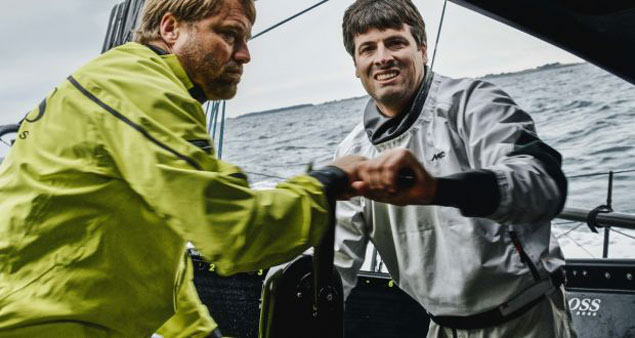 Nicholas ‘Nin’ O’Leary (right) with co-skipper Alex Thompson on the IMOCA Open 60 Hugo Boss, which they’ll be campaigning together in Sunday’s Rolex Fastnet Race
Nicholas ‘Nin’ O’Leary (right) with co-skipper Alex Thompson on the IMOCA Open 60 Hugo Boss, which they’ll be campaigning together in Sunday’s Rolex Fastnet Race
Nin O'Leary Heads West on Kitesurfing Expo
#KITESURFING – So this is what Royal Cork Yacht Clubs' finest get up to in the closed season! A top class crew took to the air at the weekend when Triple all Ireland Sailing Champion Nicholas O'Leary led four people, two cars, six kites, five boards, 110km west on a road trip to Castlegregory, Kerry on a Kitesurf trip.
From Brian Carlin's video you can see conditions looked ideal with a six metre swell and 15-20 knots of breeze and lovely winter sunshine!!


























